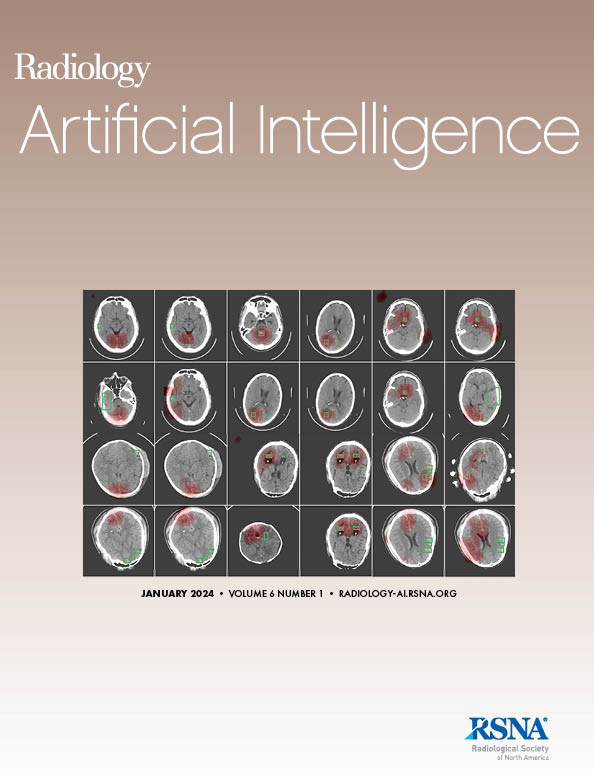Automatic Quantification of Serial PET/CT Images for Pediatric Hodgkin Lymphoma Using a Longitudinally Aware Segmentation Network.
IF 13.2
Q1 COMPUTER SCIENCE, ARTIFICIAL INTELLIGENCE
Xin Tie, Muheon Shin, Changhee Lee, Scott B Perlman, Zachary Huemann, Amy J Weisman, Sharon M Castellino, Kara M Kelly, Kathleen M McCarten, Adina L Alazraki, Junjie Hu, Steve Y Cho, Tyler J Bradshaw
下载PDF
{"title":"Automatic Quantification of Serial PET/CT Images for Pediatric Hodgkin Lymphoma Using a Longitudinally Aware Segmentation Network.","authors":"Xin Tie, Muheon Shin, Changhee Lee, Scott B Perlman, Zachary Huemann, Amy J Weisman, Sharon M Castellino, Kara M Kelly, Kathleen M McCarten, Adina L Alazraki, Junjie Hu, Steve Y Cho, Tyler J Bradshaw","doi":"10.1148/ryai.240229","DOIUrl":null,"url":null,"abstract":"<p><p>Purpose To develop a longitudinally aware segmentation network (LAS-Net) that can quantify serial PET/CT images for pediatric patients with Hodgkin lymphoma. Materials and Methods This retrospective study included baseline (PET1) and interim (PET2) PET/CT images from 297 pediatric patients enrolled in two Children's Oncology Group clinical trials (AHOD1331 and AHOD0831). The internal dataset included 200 patients (enrolled between March 2015 and August 2019; median age, 15.4 years [range, 5.6-22.0 years]; 107 male), and the external testing dataset included 97 patients (enrolled between December 2009 and January 2012; median age, 15.8 years [range, 5.2-21.4 years]; 59 male). LAS-Net incorporates longitudinal cross-attention, allowing relevant features from PET1 to inform the analysis of PET2. The model's lesion segmentation performance on PET1 images was evaluated using Dice coefficients, and lesion detection performance on PET2 images was evaluated using F1 scores. In addition, quantitative PET metrics, including metabolic tumor volume (MTV) and total lesion glycolysis (TLG) in PET1, as well as qPET and percentage difference between baseline and interim maximum standardized uptake value (∆SUV<sub>max</sub>) in PET2, were extracted and compared against physician-derived measurements. Agreement between model and physician-derived measurements was quantified using Spearman correlation, and bootstrap resampling was used for statistical analysis. Results LAS-Net detected residual lymphoma on PET2 scans with an F1 score of 0.61 (precision/recall: 0.62/0.60), outperforming all comparator methods (<i>P</i> < .01). For baseline segmentation, LAS-Net achieved a mean Dice score of 0.77. In PET quantification, LAS-Net's measurements of qPET, ∆SUV<sub>max</sub>, MTV, and TLG were strongly correlated with physician measurements, with Spearman ρ values of 0.78, 0.80, 0.93, and 0.96, respectively. The quantification performance remained high, with a slight decrease, in an external testing cohort. Conclusion LAS-Net demonstrated significant improvements in quantifying PET metrics across serial scans in pediatric patients with Hodgkin lymphoma, highlighting the value of longitudinal awareness in evaluating multi-time-point imaging datasets. <b>Keywords:</b> Pediatrics, PET/CT, Lymphoma, Segmentation, Quantification, Supervised Learning, Convolutional Neural Network (CNN), Quantitative PET, Longitudinal Analysis, Deep Learning, Image Segmentation <i>Supplemental material is available for this article.</i> Clinical trial registration no. NCT02166463 and NCT01026220 © RSNA, 2025 See also commentary by Khosravi and Gichoya in this issue.</p>","PeriodicalId":29787,"journal":{"name":"Radiology-Artificial Intelligence","volume":" ","pages":"e240229"},"PeriodicalIF":13.2000,"publicationDate":"2025-05-01","publicationTypes":"Journal Article","fieldsOfStudy":null,"isOpenAccess":false,"openAccessPdf":"https://www.ncbi.nlm.nih.gov/pmc/articles/PMC12127956/pdf/","citationCount":"0","resultStr":null,"platform":"Semanticscholar","paperid":null,"PeriodicalName":"Radiology-Artificial Intelligence","FirstCategoryId":"1085","ListUrlMain":"https://doi.org/10.1148/ryai.240229","RegionNum":0,"RegionCategory":null,"ArticlePicture":[],"TitleCN":null,"AbstractTextCN":null,"PMCID":null,"EPubDate":"","PubModel":"","JCR":"Q1","JCRName":"COMPUTER SCIENCE, ARTIFICIAL INTELLIGENCE","Score":null,"Total":0}
引用次数: 0
引用
批量引用
Abstract
Purpose To develop a longitudinally aware segmentation network (LAS-Net) that can quantify serial PET/CT images for pediatric patients with Hodgkin lymphoma. Materials and Methods This retrospective study included baseline (PET1) and interim (PET2) PET/CT images from 297 pediatric patients enrolled in two Children's Oncology Group clinical trials (AHOD1331 and AHOD0831). The internal dataset included 200 patients (enrolled between March 2015 and August 2019; median age, 15.4 years [range, 5.6-22.0 years]; 107 male), and the external testing dataset included 97 patients (enrolled between December 2009 and January 2012; median age, 15.8 years [range, 5.2-21.4 years]; 59 male). LAS-Net incorporates longitudinal cross-attention, allowing relevant features from PET1 to inform the analysis of PET2. The model's lesion segmentation performance on PET1 images was evaluated using Dice coefficients, and lesion detection performance on PET2 images was evaluated using F1 scores. In addition, quantitative PET metrics, including metabolic tumor volume (MTV) and total lesion glycolysis (TLG) in PET1, as well as qPET and percentage difference between baseline and interim maximum standardized uptake value (∆SUVmax ) in PET2, were extracted and compared against physician-derived measurements. Agreement between model and physician-derived measurements was quantified using Spearman correlation, and bootstrap resampling was used for statistical analysis. Results LAS-Net detected residual lymphoma on PET2 scans with an F1 score of 0.61 (precision/recall: 0.62/0.60), outperforming all comparator methods (P < .01). For baseline segmentation, LAS-Net achieved a mean Dice score of 0.77. In PET quantification, LAS-Net's measurements of qPET, ∆SUVmax , MTV, and TLG were strongly correlated with physician measurements, with Spearman ρ values of 0.78, 0.80, 0.93, and 0.96, respectively. The quantification performance remained high, with a slight decrease, in an external testing cohort. Conclusion LAS-Net demonstrated significant improvements in quantifying PET metrics across serial scans in pediatric patients with Hodgkin lymphoma, highlighting the value of longitudinal awareness in evaluating multi-time-point imaging datasets. Keywords: Pediatrics, PET/CT, Lymphoma, Segmentation, Quantification, Supervised Learning, Convolutional Neural Network (CNN), Quantitative PET, Longitudinal Analysis, Deep Learning, Image Segmentation Supplemental material is available for this article. Clinical trial registration no. NCT02166463 and NCT01026220 © RSNA, 2025 See also commentary by Khosravi and Gichoya in this issue.
基于纵向感知分割网络的儿童霍奇金淋巴瘤系列PET/CT图像自动量化。
“刚刚接受”的论文经过了全面的同行评审,并已被接受发表在《放射学:人工智能》杂志上。这篇文章将经过编辑,布局和校样审查,然后在其最终版本出版。请注意,在最终编辑文章的制作过程中,可能会发现可能影响内容的错误。目的建立纵向感知的分割网络(LAS-Net),用于量化儿童霍奇金淋巴瘤患者的连续PET/CT图像。材料和方法本回顾性研究纳入了297名儿童肿瘤组临床试验(AHOD1331和AHOD0831)的儿童患者的基线(PET1)和中期(PET2) PET/CT图像。内部数据集包括200名患者(2015年3月至2019年8月;中位年龄15.4岁[IQR: 5.6, 22.0]岁;外部测试数据集包括97例患者(2009年12月至2012年1月入组;中位年龄15.8岁[IQR: 5.2, 21.4]岁;59岁男性)。LAS-Net结合了纵向交叉注意,允许PET1的相关特征为PET2的分析提供信息。使用Dice系数评价模型对PET1图像的病灶分割性能,使用F1分数评价模型对PET2图像的病灶检测性能。此外,提取定量PET指标,包括PET1中的代谢肿瘤体积(MTV)和总病变糖酵解(TLG),以及PET2中的qPET和∆SUVmax,并与医生提供的测量结果进行比较。采用Spearman相关对模型和医生测量结果之间的一致性进行量化,并采用自举重采样进行统计分析。结果LAS-Net在PET2扫描中检测到残留淋巴瘤,F1评分为0.61(精密度/召回率:0.62/0.60),优于所有比较方法(P < 0.01)。对于基线分割,LAS-Net的平均Dice得分为0.77。在PET定量中,LAS-Net测量的qPET、∆SUVmax、MTV和TLG与医生测量值密切相关,Spearman的ρ值分别为0.78、0.80、0.93和0.96。在外部测试队列中,量化表现仍然很高,略有下降。结论:LAS-Net在量化霍奇金淋巴瘤儿童患者串行扫描的PET指标方面有显著改善,突出了纵向感知在评估多时间点成像数据集中的价值。©RSNA, 2025年。
本文章由计算机程序翻译,如有差异,请以英文原文为准。

 求助内容:
求助内容: 应助结果提醒方式:
应助结果提醒方式:


